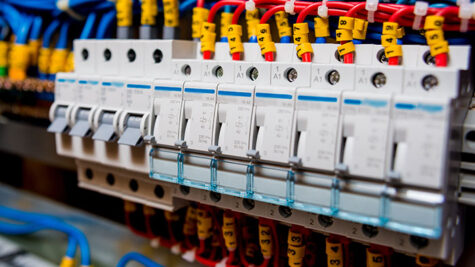A few remarks on relays
Electromagnetic relays are most frequently used for load switching. The majority of mass-produced products use relays with silver and nickel alloy (AgNi) coated terminals. These relays have been a success, at first glance…
So what is the problem? The rated current of the relay is 10A, so you connect a load whose load current does not exceed 10A… But this calculation may be wrong: the problem is the inrush current.
Filament lamps
While a lamp filament is cold, it has low resistance, but when turned on the filament is heated and the resistance increases (for instance, a 75W filament lamp has something like a 50 Ohm resistance when cold and 650 Ohm resistance when turned on). Correspondingly, the inrush current for a filament lamp is 8-10 times higher than the rated one.
The duration of the inrush current of a filament lamp is about 3-5 ms.
LED lighting
LEDs alone do not induce an inrush current, but the pulse converters supplying DС to LEDs do. The main problem is current, induced by the charge of capacitors used at the power supply inputs.
The LED lightbulb of big brands can have an inrush current 10-20 times higher than the rated current, while noname LED lightbulbs can have an inrush current 50-200 times higher than the rated current. The duration of the inrush current is usually in the range of 100-250 mcs.
Pulse Power Supply Unit
Similarly to LED lights, these power sources have supercapacitors at the input. However, supply units have NTC thermistors at the input, reducing (not eliminating) the inrush current. The duration of the inrush current is usually in the range of 200-500 mcs.
Electrical motors
At an inductive load, a motor has zero inrush current. However, if the switching on moment coincides with a sinusoid crossing zero – the starting current surge is doubled. Also, by the time a motor rotates with its rated speed, the current value exceeds the rated value by several times. The more powerful a motor is, the greater this over-rating.
Heaters (kettles, irons, heating elements, etc.)
The temperature factor of nickel-chrome coils is very low, and the inrush current is close to the rated current.
Conclusions
The manufacturer can indicate several types of current in the relay documentation: contact rating current and max. switching current or inrush current. In standard relays manufacturers do not usually indicate the inrush current. This means that the rated current and inrush current are equal.
Therefore, when using a standard relay, you need to limit the load or be prepared to change the relay frequently (because of terminal welding). It is better to use specially designed relays for loads with a high inrush current.

We use relays with silver and tin alloy (AgSnO2) coated terminals that have a rating TV-5 (inrush currents up to 80А)
These exact specially designed relays (withstanding inrush currents up to 80A), with silver and tin alloy (AgSnO2) coated terminals that have a higher melting point, are installed in ION CS-8 Central switch. This gives particular resistance to contact damage and terminal welding when switching loads. The higher the contact damage resistance, the longer the relay service life and therefore the longer the life of the device.

More to read





FAQ
-
What is Inrush Current?
When turning on an electrical appliance, transient processes usually occur. Additionally, to run a device more power might be required than when it is in operational mode. Due to that, the phenomenon of inrush (starting) current occurs. The inrush current value is the maximum incoming current when the appliance is switched on.
Therefore, the relays that switch the load must be carefully chosen.
-
What are inrush current values of LED lamps ?
A LED lamp inrush current:
- Big brands – 10-20 times higher than the rated current (the duration 100 – 250 mcs).
- Noname brands – 50-200 times higher than the rated current (the duration 100 – 500 mcs).
-
What are inrush current values of filament lamps?
A filament lamp inrush current is 8-10 times higher than the rated.
The duration of the inrush current of a filament lamp is about 3-5 ms.
